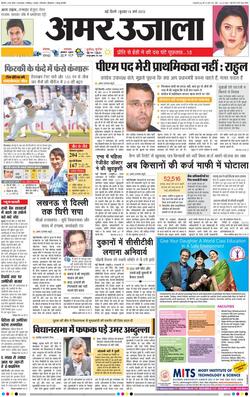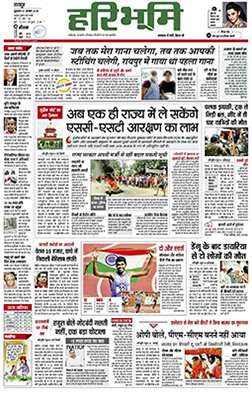Related Research Articles

A consumer price index (CPI) is a price index, the price of a weighted average market basket of consumer goods and services purchased by households. Changes in measured CPI track changes in prices over time.
The Indian media consists of several different types of communications of mass media: television, radio, cinema, newspapers, magazines, and Internet-based websites/portals. Indian media was active since the late 18th century. The print media started in India as early as 1780. Radio broadcasting began in 1927. Today much of the media is controlled by large, corporations, which reap revenue from advertising, subscriptions, and sale of copyrighted material.

Consumer behavior is the study of individuals, groups, or organizations and all the activities associated with the purchase, use and disposal of goods and services. Consumer behaviour consists of how the consumer's emotions, attitudes, and preferences affect buying behaviour. Consumer behaviour emerged in the 1940–1950s as a distinct sub-discipline of marketing, but has become an interdisciplinary social science that blends elements from psychology, sociology, social anthropology, anthropology, ethnography, ethnology, marketing, and economics.
The television industry in India is very diverse and produces thousands of programs in many of the Indian languages. More than half of all Indian households own a television. As of 2016, the country had over 857 channels of which 184 were pay channels. National channels operate in Hindi and English, in addition to regional channels in several languages including Tamil, Telugu, Kannada, Malayalam, Bengali, Marathi, Odia, Punjabi, Assamese, Gujarati, Urdu, Bhojpuri, Kashmiri, Konkani and Haryanvi, among others. The Hindi, Telugu and Tamil language television industries are by far the largest television industries in India.
The PCE price index (PePP), also referred to as the PCE deflator, PCE price deflator, or the Implicit Price Deflator for Personal Consumption Expenditures by the Bureau of Economic Analysis (BEA) and as the Chain-type Price Index for Personal Consumption Expenditures (CTPIPCE) by the Federal Open Market Committee (FOMC), is a United States-wide indicator of the average increase in prices for all domestic personal consumption. It is benchmarked to a base of 2012 = 100. Using a variety of data including U.S. Consumer Price Index and Producer Price Index prices, it is derived from the largest component of the GDP in the BEA's National Income and Product Accounts, personal consumption expenditures.

Fast-moving consumer goods (FMCG), also known as consumer packaged goods (CPG), are products that are sold quickly and at a relatively low cost. Examples include non-durable household goods such as packaged foods, beverages, toiletries, candies, cosmetics, over-the-counter drugs, dry goods, and other consumables.
Audience measurement measures how many people are in an audience, usually in relation to radio listenership and television viewership, but also in relation to newspaper and magazine readership and, increasingly, web traffic on websites. Sometimes, the term is used as pertaining to practices which help broadcasters and advertisers determine who is listening rather than just how many people are listening. In some parts of the world, the resulting relative numbers are referred to as audience share, while in other places the broader term market share is used. This broader meaning is also called audience research.
The Consumer Expenditure Survey is a Bureau of Labor Statistics (BLS) household survey that collects information on the buying habits of U.S. consumers. The program consists of two components — the Interview Survey and the Diary Survey — each with its own sample. The surveys collect data on expenditures, income, and consumer unit characteristics. In May 2020, the American Association for Public Opinion Research recognized the CE program with its 2020 Policy Impact Award, for joint work by the BLS -- including CE and the Division of Price and Index Number Research -- and the Census Bureau on the Supplemental Poverty thresholds and measure, and the essential contributions these data products have made to the understanding, discussion, and advancement of public policy related to the alleviation of poverty in the United States.

Amar Ujala is a Hindi-language daily newspaper published in India which was founded in 1948. It has 22 editions in six states and two union territories covering 180 districts. It has a circulation of around two million copies. The 2017 Indian Readership Survey reported that with 46.094 million it had the 4th-largest daily readership amongst newspapers in India.
Kantar IMRB is a market research, survey and business consultancy firm. It is headquartered in Mumbai, India and has operations in over 15 countries. IMRB is a part of the Kantar Group, WPP’s research, insights, and consultancy network.
The Ministry of Statistics and Programme Implementation (MoSPI) is a ministry of Government of India concerned with coverage and quality aspects of statistics released. The surveys conducted by the Ministry are based on scientific sampling methods.
Single-source data is the measurement of TV and/or other mass media's advertising exposure and purchase behavior, over time for the same individual or household. This measurement is gauged through the collection of data components supplied by one or more parties overlapped through a single, integrated system of data collection matched to the person or household level. How these data are stored is known as a single-source database.

Lacto-ovo vegetarianism or ovo-lacto vegetarianism is a type of vegetarianism which forbids animal flesh but allows the consumption of animal products such as dairy and eggs. Unlike pescetarianism, it does not include fish or other seafood. A typical ovo-lacto vegetarian diet may include fruits, vegetables, grains, legumes, meat substitutes, nuts, seeds, soy, cheese, milk, yogurt and eggs.

Hari Bhoomi is a daily newspaper published in North and Central India. Established on 5 September 1996 as a weekly Hindi language newspaper, in November 1997, it was converted into a daily newspaper and was started in Haryana as the Hari Bhoomi 'Rohtak’ edition. With this edition the newspaper covered news from the whole state of Haryana.

Non-vegetarian food contains meat, and sometimes, eggs. The term is common in India, but not usual elsewhere. In the generally vegetarian environment of India, restaurants offering meat and fish usually have a "non-vegetarian" section of their menu, and may include the term in their name-boards and advertising. When describing people, non-vegetarians eat meat and/or eggs, as opposed to vegetarians. But in India, consumption of dairy foods is usual for both groups.
Predictive intake modelling uses mathematical modelling strategies to estimate intake of food, personal care products, and their formulations.

The Broadcast Audience Research Council (BARC) India is a joint industry body founded by organisations that represent Indian broadcasters (IBDF), advertisers (ISA), and advertising and media agencies (AAAI). It is the world's largest television measurement science industry body.
The fast-moving consumer goods (FMCG) industry or consumer packaged goods (CPG) industry is mainly responsible for producing, distributing and marketing fast-moving consumer goods. The FMCG industry is the fourth largest sector in the Indian economy. Household and personal care products accounts for 50% of the sales in the industry, healthcare accounts for 31-32% and food and beverage accounts for the remaining 18-19%.
The Centre for Monitoring Indian Economy (CMIE) is an independent private limited entity that serves both as an economic think-tank as well as a business information company. CMIE research group has built databases on the Indian economy and private companies. CMIE provides this information in the form of databases and research reports via a subscription-based business model. It is headquartered in Mumbai, with additional offices in India.
References
- ↑ "Media Research Users Council – IRS Introduction – Providing In-depth Research Knowledge to Media Buyers & Sellers". Mruc.net. Retrieved 2014-02-28.
- ↑ "Media Research Users Council – IRS FAQ". Mruc.net. Retrieved 2014-02-28.
- ↑ "IRS 2013 has shocking anomalies defying logic". The Hindu. 2014-01-31. Retrieved 2014-02-28.
- ↑ "Media Research Users Council - IRS FAQ". Mruc.net. Retrieved 2014-02-28.
- ↑ "Media Research Users Council - IRS Methodology". Mruc.net. Retrieved 2014-02-28.
- ↑ "Indian Readership Survey (IRS)". Hansaresearch.com. Archived from the original on 2013-01-25. Retrieved 2014-02-28.
- ↑ "18 top media houses rubbish readership survey findings - The Times of India". Timesofindia.indiatimes.com. 2014-01-31. Retrieved 2014-02-28.